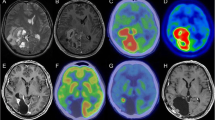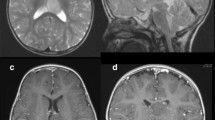Abstract
Recent advances in genomic technology and genome-wide analysis have identified key molecular alterations that are relevant to the diagnosis and prognosis of brain tumors. Molecular information such as mutations in isocitrate dehydrogenase (IDH) genes or 1p/19q co-deletion status will be more actively incorporated into the histological classification of diffuse gliomas. BRAF V600E mutations are found frequently in circumscribed low-grade gliomas such as pleomorphic xanthoastrocytoma (PXA) and extra-cerebellar pilocytic astrocytoma, or epithelioid glioblastomas (E–GBM), a rare variant of GBM. This mutation is relatively rare in other types of diffuse gliomas, especially in adult onset cases. Here, we present an adult onset case of IDH wild-type/BRAF V600E-mutated diffuse glioma, evolving from grade III to grade IV. The tumor displayed atypical exophytic growth and had unusual histological features not fully compatible with, but indicative of PXA and E-GBM. We discuss differential diagnosis of the tumor, and review previously described diffuse gliomas with the BRAF V600E mutation.

Similar content being viewed by others
References
Louis D, Ohgaki H, Wiestler O et al (2007) WHO classification of tumours of the central nervous system, 4th edn. International Agency for Research on Cancer, Lyon
Cairncross G, Berkey B, Shaw E et al (2006) Phase III trial of chemotherapy plus radiotherapy compared with radiotherapy alone for pure and mixed anaplastic oligodendroglioma: intergroup Radiation Therapy Oncology Group Trial 9402. J Clin Oncol Off J Am Soc Clin Oncol 24:2707–2714
van den Bent MJ, Carpentier AF, Brandes AA et al (2006) Adjuvant procarbazine, lomustine, and vincristine improves progression-free survival but not overall survival in newly diagnosed anaplastic oligodendrogliomas and oligoastrocytomas: a randomized European Organisation for Research and Treatment of Cancer phase III trial. J Clin Oncol Off J Am Soc Clin Oncol 24:2715–2722
Parsons DW, Jones S, Zhang X et al (2008) An integrated genomic analysis of human glioblastoma multiforme. Science (New York, NY) 321:1807–1812
Weller M, Felsberg J, Hartmann C et al (2009) Molecular predictors of progression-free and overall survival in patients with newly diagnosed glioblastoma: a prospective translational study of the German Glioma Network. J Clin Oncol Off J Am Soc Clin Oncol 27:5743–5750
Balss J, Meyer J, Mueller W et al (2008) Analysis of the IDH1 codon 132 mutation in brain tumors. Acta Neuropathol 116:597–602
Watanabe T, Nobusawa S, Kleihues P et al (2009) IDH1 mutations are early events in the development of astrocytomas and oligodendrogliomas. Am J Pathol 174:1149–1153
Yan H, Parsons DW, Jin G et al (2009) IDH1 and IDH2 mutations in gliomas. New Engl J Med 360:765–773
Ichimura K, Pearson DM, Kocialkowski S et al (2009) IDH1 mutations are present in the majority of common adult gliomas but rare in primary glioblastomas. Neuro Oncol 11:341–347
Ohgaki H, Kleihues P (2009) Genetic alterations and signaling pathways in the evolution of gliomas. Cancer Sci 100:2235–2241
Ichimura K (2012) Molecular pathogenesis of IDH mutations in gliomas. Brain Tumor Pathol 29:131–139
Suzuki H, Aoki K, Chiba K et al (2015) Mutational landscape and clonal architecture in grade II and III gliomas. Nat Genet 47:458–468
Jones DT, Kocialkowski S, Liu L et al (2008) Tandem duplication producing a novel oncogenic BRAF fusion gene defines the majority of pilocytic astrocytomas. Cancer Res 68:8673–8677
Pfister S, Janzarik WG, Remke M et al (2008) BRAF gene duplication constitutes a mechanism of MAPK pathway activation in low-grade astrocytomas. J Clin Investig 118:1739–1749
Jones DTW, Kocialkowski S, Liu L et al (2009) Oncogenic RAF1 rearrangement and a novel BRAF mutation as alternatives to KIAA1549: BRAF fusion in activating the MAPK pathway in pilocytic astrocytoma. Oncogene 28:2119–2123
Schiffman JD, Hodgson JG, VandenBerg SR et al (2010) Oncogenic BRAF mutation with CDKN2A inactivation is characteristic of a subset of pediatric malignant astrocytomas. Cancer Res 70:512–519
Schindler G, Capper D, Meyer J et al (2011) Analysis of BRAF V600E mutation in 1,320 nervous system tumors reveals high mutation frequencies in pleomorphic xanthoastrocytoma, ganglioglioma and extra-cerebellar pilocytic astrocytoma. Acta Neuropathol 121:397–405
Zhang J, Wu G, Miller CP et al (2013) Whole-genome sequencing identifies genetic alterations in pediatric low-grade gliomas. Nat Genet 45:602–612
Davies H, Bignell GR, Cox C et al (2002) Mutations of the BRAF gene in human cancer. Nature 417:949–954
Wan PT, Garnett MJ, Roe SM et al (2004) Mechanism of activation of the RAF-ERK signaling pathway by oncogenic mutations of B-RAF. Cell 116:855–867
Dougherty MJ, Santi M, Brose MS et al (2010) Activating mutations in BRAF characterize a spectrum of pediatric low-grade gliomas. Neuro Oncol 12:621–630
Dias-Santagata D, Lam Q, Vernovsky K et al (2011) BRAF V600E mutations are common in pleomorphic xanthoastrocytoma: diagnostic and therapeutic implications. PLoS One 6:e17948
Kleinschmidt-DeMasters BK, Aisner DL, Birks DK et al (2013) Epithelioid GBMs show a high percentage of BRAF V600E mutation. Am J Surg Pathol 37:685–698
Broniscer A, Tatevossian RG, Sabin ND et al (2014) Clinical, radiological, histological and molecular characteristics of paediatric epithelioid glioblastoma. Neuropathol Appl Neurobiol 40:327–336
Nobusawa S, Hirato J, Kurihara H et al (2014) Intratumoral heterogeneity of genomic imbalance in a case of epithelioid glioblastoma with BRAF V600E mutation. Brain Pathol (Zurich, Switzerland) 24:239–246
Tanaka S, Nakada M, Nobusawa S et al (2014) Epithelioid glioblastoma arising from pleomorphic xanthoastrocytoma with the BRAF V600E mutation. Brain Tumor Pathol 31:172–176
Kleinschmidt-DeMasters BK, Aisner DL, Foreman NK (2015) BRAF VE1 immunoreactivity patterns in epithelioid glioblastomas positive for BRAF V600E mutation. Am J Surg Pathol 39:528–540
Tanaka K, Sasayama T, Kawamura A et al (2006) Isolated oculomotor nerve paresis in anaplastic astrocytoma with exophytic invasion. Neurol Med Chir (Tokyo) 46:198–201
Chi AS, Batchelor TT, Yang D et al (2013) BRAF V600E mutation identifies a subset of low-grade diffusely infiltrating gliomas in adults. J Clin Oncol Off J Am Soc Clin Oncol 31:e233–e236
Knobbe CB, Reifenberger J, Reifenberger G (2004) Mutation analysis of the Ras pathway genes NRAS, HRAS, KRAS and BRAF in glioblastomas. Acta Neuropathol 108:467–470
Basto D, Trovisco V, Lopes JMM et al (2005) Mutation analysis of B-RAF gene in human gliomas. Acta Neuropathol 109:207–210
Jeuken J, van den Broecke C, Gijsen S et al (2007) RAS/RAF pathway activation in gliomas: the result of copy number gains rather than activating mutations. Acta Neuropathol 114:121–133
Hagemann C, Gloger J, Anacker J et al (2009) RAF expression in human astrocytic tumors. Int J Mol Med 23:17–31
MacConaill LE, Campbell CD, Kehoe SM et al (2009) Profiling critical cancer gene mutations in clinical tumor samples. PLoS One 4:e7887
Sievert AJ, Jackson EM, Gai X et al (2009) Duplication of 7q34 in pediatric low-grade astrocytomas detected by high-density single-nucleotide polymorphism-based genotype arrays results in a novel BRAF fusion gene. Brain Pathol (Zurich, Switzerland) 19:449–458
Nicolaides TP, Li H, Solomon DA et al (2011) Targeted therapy for BRAFV600E malignant astrocytoma. Clin Cancer Res Off J Am Assoc Cancer Res 17:7595–7604
Badiali M, Gleize V, Paris S et al (2012) KIAA1549-BRAF fusions and IDH mutations can coexist in diffuse gliomas of adults. Brain Pathol (Zurich, Switzerland) 22:841–847
Horbinski C, Nikiforova MN, Hagenkord JM et al (2012) Interplay among BRAF, p16, p53, and MIB1 in pediatric low-grade gliomas. Neuro Oncol 14:777–789
Kim Y-HH, Nonoguchi N, Paulus W et al (2012) Frequent BRAF gain in low-grade diffuse gliomas with 1p/19q loss. Brain pathology (Zurich, Switzerland) 22:834–840
Lin A, Rodriguez FJ, Karajannis MA et al (2012) BRAF alterations in primary glial and glioneuronal neoplasms of the central nervous system with identification of 2 novel KIAA1549:BRAF fusion variants. J Neuropathol Exp Neurol 71:66–72
Myung JK, Cho H, Park C-KK et al (2012) Analysis of the BRAF(V600E) mutation in central nervous system tumors. Transl Oncol 5:430–436
Bettegowda C, Agrawal N, Jiao Y et al (2013) Exomic sequencing of four rare central nervous system tumor types. Oncotarget 4:572–583
Ramkissoon LA, Horowitz PM, Craig JM et al (2013) Genomic analysis of diffuse pediatric low-grade gliomas identifies recurrent oncogenic truncating rearrangements in the transcription factor MYBL1. Proc Natl Acad Sci USA 110:8188–8193
Bleeker FE, Lamba S, Zanon C et al (2014) Mutational profiling of kinases in glioblastoma. BMC Cancer 14:718
Fernandez-Vega I, Quirk J, Norwood FL et al (2014) Gliomatosis cerebri type 1 with extensive involvement of the spinal cord and BRAF V600E mutation. Pathol Oncol Res POR 20:215–220
Robinson GW, Orr BA, Gajjar A (2014) Complete clinical regression of a BRAF V600E-mutant pediatric glioblastoma multiforme after BRAF inhibitor therapy. BMC Cancer 14:258
Roth JJ, Santi M, Rorke-Adams LB et al (2014) Diagnostic application of high resolution single nucleotide polymorphism array analysis for children with brain tumors. Cancer Genet 207:111–123
Gierke M, Sperveslage J, Schwab D et al (2015) Analysis of IDH1-R132 mutation, BRAF V600 mutation and KIAA1549-BRAF fusion transcript status in central nervous system tumors supports pediatric tumor classification. J Cancer Res Clin Oncol 27 [Epub ahead of print]
Korshunov A, Ryzhova M, Hovestadt V et al (2015) Integrated analysis of pediatric glioblastoma reveals a subset of biologically favorable tumors with associated molecular prognostic markers. Acta Neuropathol 129:669–678
Mistry M, Zhukova N, Merico D et al (2015) BRAF mutation and CDKN2A deletion define a clinically distinct subgroup of childhood secondary high-grade glioma. J Clin Oncol Off J Am Soc Clin Oncol 33:1015–1022
Takahashi Y, Akahane T, Sawada T et al (2015) Adult classical glioblastoma with a BRAF V600E mutation. World J Surg Oncol 13:100
Weber RG, Hoischen A, Ehrler M et al (2007) Frequent loss of chromosome 9, homozygous CDKN2A/p14(ARF)/CDKN2B deletion and low TSC1 mRNA expression in pleomorphic xanthoastrocytomas. Oncogene 26:1088–1097
Kleinschmidt-DeMasters BK, Meltesen L, McGavran L et al (2006) Characterization of glioblastomas in young adults. Brain Pathol (Zurich, Switzerland) 16:273–286
Rodriguez FJ, Scheithauer BW, Giannini C et al (2008) Epithelial and pseudoepithelial differentiation in glioblastoma and gliosarcoma: a comparative morphologic and molecular genetic study. Cancer 113:2779–2789
Bette Kay K-D, Ali HA, Diane KB et al (2010) Epithelioid versus rhabdoid glioblastomas are distinguished by monosomy 22 and immunohistochemical expression of INI-1 but not claudin 6. Am J Surg Pathol 34:341–354
Alexandrescu S, Korshunov A, Lai SH et al (2015) Epithelioid glioblastomas and anaplastic epithelioid pleomorphic xanthoastrocytomas—same entity or first cousins? Brain pathology (Zurich, Switzerland) bpa.12295. [Epub ahead of print]
Shogo E, Shunsuke T, Shigeru Y et al (2013) Primary rhabdoid tumor with low grade glioma component of the central nervous system in a young adult. Neuropathology 33:185–191
Dahiya S, Emnett RJ, Haydon DH et al (2014) BRAF-V600E mutation in pediatric and adult glioblastoma. Neuro Oncol 16:318–319
Acknowledgments
We thank Dr. M Ruberg for a critical reading of the manuscript, Drs. Shinji Ito and Dr. Takashi Komori for the immunohistochemistry, and the latter for kind advice concerning the diagnosis.
Author information
Authors and Affiliations
Corresponding author
Rights and permissions
About this article
Cite this article
Suzuki, Y., Takahashi-Fujigasaki, J., Akasaki, Y. et al. BRAF V600E-mutated diffuse glioma in an adult patient: a case report and review. Brain Tumor Pathol 33, 40–49 (2016). https://doi.org/10.1007/s10014-015-0234-4
Received:
Accepted:
Published:
Issue Date:
DOI: https://doi.org/10.1007/s10014-015-0234-4




